Neuroinflammation in Aged Brain: Impact of the Oral Administration of Ellagic Acid Microdispersion
Abstract
1. Introduction
2. Results
2.1. The Chronic Oral Administration of the EAm in Young and Aged Mice: Control of Daily Intake and Weight Gain
2.2. Evaluation of the Effects of the Oral Administration of EAm on Behavioural Skills in “In Vivo” Studies in Young and Aged Mice Using a Univariate Approach
2.3. Evaluation of the Effects of the Oral Administration of EAm on Behavioural Skills in “In Vivo” Studies in Young and Aged Mice Using a Multivariate Approach
2.4. Effects of the Oral Administration of EAm on “Ex Vivo, In Vitro” Cortical Noradrenergic Synaptosomes from Young and Aged Mice
2.5. Effects of the Oral Administration of EAm on Markers that Typify Inflammation in the Cortex of Young and Aged Mice
2.6. Effects of the Oral Administration of EAm on the Cytokine Levels in the Cortex of Young and Aged Mice
3. Discussion
4. Materials and Methods
4.1. EA Microdispersion and EA Drug Loading Analysis of the Drinking Daily Solutions
4.2. Animals
4.3. Animal Treatment
4.4. Behavioural Tests
4.5. Preparation of Synaptosomes
4.6. Experiments of Release
4.7. Cytokines Measurements
4.8. qRT-PCR Cytokine mRNA Quantification
4.9. Western Blot Analysis
4.10. Calculations and Statistical Analysis
4.11. Drugs
Author Contributions
Funding
Conflicts of Interest
Abbreviations
| EA | Ellagic Acid |
| EAm | Ellagic Acid Micro-Dispersion |
| CNS | Central Nervous System |
| ETs | Ellagitannins |
| UROs | Urolithins |
| IS | Immune System |
| DL | Drug Loading |
| SNV | Standard Normal Variate |
| PCA | Principal Component Analysis |
| PC | Principal Component |
| GFAP | Glial Fibrillar Astrocytic Protein |
| [3H]NA | [3H]noradrenaline |
| IBA-1 | Ionized Calcium Binding Adaptor Molecule |
| CD45 | Classification Determinant 45 |
| TNF- | Tumor Necrosis Factor- |
| IL-1β | Interleukin-1β |
| IL-6 | Interleukin-6 |
| PCR | Polymerase Chain Reaction |
| RT-PCR | Real Time-PCR |
| NA | Noradrenaline |
References
- Deak, F. Neuronal Vesicular Trafficking and Release in Age-Related Cognitive Impairment. J. Gerontol. Ser. A Biol. Sci. Med Sci. 2014, 69, 1325–1330. [Google Scholar] [CrossRef] [PubMed]
- Mather, M.; Harley, C.W. The Locus Coeruleus: Essential for Maintaining Cognitive Function and the Aging Brain. Trends Cogn. Sci. 2016, 20, 214–226. [Google Scholar] [CrossRef] [PubMed]
- Segovia, G.; Arco, A.; Mora, F. Environmental Enrichment, Prefrontal Cortex, Stress, and Aging of the Brain. J. Neural Transm. 2009, 116, 1007–1016. [Google Scholar] [CrossRef] [PubMed]
- Liguz-Lecznar, M.; Lehner, M.; Kaliszewska, A.; Zakrzewska, R.; Sobolewska, A.; Kossut, M. Altered Glutamate/GABA Equilibrium in Aged Mice Cortex Influences Cortical Plasticity. Brain Struct. Funct. 2015, 220, 1681–1693. [Google Scholar] [CrossRef] [PubMed]
- Pittaluga, A. Acute Functional Adaptations in Isolated Presynaptic Terminals Unveil Synaptosomal Learning and Memory. Int. J. Mol. Sci. 2019, 20, 3641. [Google Scholar] [CrossRef]
- Bonfiglio, T.; Vergassola, M.; Olivero, G.; Pittaluga, A. Environmental Training and Synaptic Functions in Young and Old Brain: A Presynaptic Perspective. Curr. Med. Chem. 2019, 26, 3670–3684. [Google Scholar] [CrossRef]
- Feart, C. Nutrition and Frailty: Current Knowledge. Prog. Neuro Psychopharmacol. Biol. Psychiatry 2019, 95, 109703. [Google Scholar] [CrossRef]
- Ogle, W.O.; Speisman, R.B.; Ormerod, B.K. Potential of Treating Age-Related Depression and Cognitive Decline with Nutraceutical Approaches: A Mini-Review. Gerontology 2013, 59, 23–31. [Google Scholar] [CrossRef]
- Schättin, A.; Baur, K.; Stutz, J.; Wolf, P.; de Bruin, E.D. Effects of Physical Exercise Combined with Nutritional Supplements on Aging Brain Related Structures and Functions: A Systematic Review. Front. Aging Neurosci. 2016, 8, 161. [Google Scholar] [CrossRef]
- Bigliardi, B.; Galati, F. Innovation Trends in the Food Industry: The Case of Functional Foods. Trends Food Sci. Technol. 2013, 31, 118–129. [Google Scholar] [CrossRef]
- Iwatani, S.; Yamamoto, N. Functional Food Products in Japan: A Review. Food Sci. Hum. Wellness 2019, 8, 96–101. [Google Scholar] [CrossRef]
- Shahidi, F.; Ambigaipalan, P. Phenolics and Polyphenolics in Foods, Beverages and Spices: Antioxidant Activity and Health Effects–A Review. J. Funct. Foods 2015, 18, 820–897. [Google Scholar] [CrossRef]
- Ahmed, T.N.; Setzer, W.; Fazel Nabavi, S.; Erdogan Orhan, I.; Braidy, N.; Sobarzo-Sanchez, E.; Mohammad Nabavi, S. Insights into Effects of Ellagic Acid on the Nervous System: A Mini Review. Curr. Pharm. Des. 2016, 22, 1350–1360. [Google Scholar] [CrossRef] [PubMed]
- Alfei, S.; Turrini, F.; Catena, S.; Zunin, P.; Grilli, M.; Pittaluga, A.M.; Boggia, R. Ellagic Acid a Multi-Target Bioactive Compound for Drug Discovery in CNS? A Narrative Review. Eur. J. Med. Chem. 2019, 183, 111724. [Google Scholar] [CrossRef] [PubMed]
- Kim, Y.E.; Hwang, C.J.; Lee, H.P.; Kim, C.S.; Son, D.J.; Ham, Y.W.; Hellström, M.; Han, S.-B.; Kim, H.S.; Park, E.K.; et al. Inhibitory Effect of Punicalagin on Lipopolysaccharide-Induced Neuroinflammation, Oxidative Stress and Memory Impairment via Inhibition of Nuclear Factor-KappaB. Neuropharmacology 2017, 117, 21–32. [Google Scholar] [CrossRef] [PubMed]
- Welcome, M.O. Neuroinflammation in CNS Diseases: Molecular Mechanisms and the Therapeutic Potential of Plant Derived Bioactive Molecules. PharmaNutrition 2020, 11, 100176. [Google Scholar] [CrossRef]
- Bala, I.; Bhardwaj, V.; Hariharan, S.; Kumar, M.N.V.R. Analytical Methods for Assay of Ellagic Acid and Its Solubility Studies. J. Pharm. Biomed. Anal. 2006, 40, 206–210. [Google Scholar] [CrossRef]
- Tomás-Barberán, F.A.; García-Villalba, R.; González-Sarrías, A.; Selma, M.V.; Espín, J.C. Ellagic Acid Metabolism by Human Gut Microbiota: Consistent Observation of Three Urolithin Phenotypes in Intervention Trials, Independent of Food Source, Age, and Health Status. J. Agric. Food Chem. 2014, 62, 6535–6538. [Google Scholar] [CrossRef]
- González-Sarrías, A.; García-Villalba, R.; Núñez-Sánchez, M.Á.; Tomé-Carneiro, J.; Zafrilla, P.; Mulero, J.; Tomás-Barberán, F.A.; Espín, J.C. Identifying the Limits for Ellagic Acid Bioavailability: A Crossover Pharmacokinetic Study in Healthy Volunteers after Consumption of Pomegranate Extracts. J. Funct. Foods 2015, 19, 225–235. [Google Scholar] [CrossRef]
- Alfei, S.; Turrini, F.; Catena, S.; Zunin, P.; Parodi, B.; Zuccari, G.; Pittaluga, A.M.; Boggia, R. Preparation of Ellagic Acid Micro and Nano Formulations with Amazingly Increased Water Solubility by Its Entrapment in Pectin or Non-PAMAM Dendrimers Suitable for Clinical Applications. New J. Chem. 2019, 43, 2438–2448. [Google Scholar] [CrossRef]
- Turrini, F.; Boggia, R.; Donno, D.; Parodi, B.; Beccaro, G.; Baldassari, S.; Signorello, M.G.; Catena, S.; Alfei, S.; Zunin, P. From Pomegranate Marcs to a Potential Bioactive Ingredient: A Recycling Proposal for Pomegranate-Squeezed Marcs. Eur. Food Res. Technol. 2020, 246, 273–285. [Google Scholar] [CrossRef]
- Bonfiglio, T.; Olivero, G.; Merega, E.; Di Prisco, S.; Padolecchia, C.; Grilli, M.; Milanese, M.; Di Cesare Mannelli, L.; Ghelardini, C.; Bonanno, G.; et al. Prophylactic versus Therapeutic Fingolimod: Restoration of Presynaptic Defects in Mice Suffering from Experimental Autoimmune Encephalomyelitis. PLoS ONE 2017, 12, e0170825. [Google Scholar] [CrossRef] [PubMed]
- Barnes, R.J.; Dhanoa, M.S.; Lister, S.J. Standard Normal Variate Transformation and De-Trending of Near-Infrared Diffuse Reflectance Spectra. Appl. Spectrosc. 1989, 43, 772–777. [Google Scholar] [CrossRef]
- Wold, S.; Esbensen, K.; Geladi, P. Principal Component Analysis. Chemom. Intell. Lab. Syst. 1987, 2, 37–52. [Google Scholar] [CrossRef]
- Jolliffe, I.T. Principal Component Analysis, 2nd ed.; Springer series in statistics; Springer: New York, NY, USA, 2002. [Google Scholar]
- Pittaluga, A. Presynaptic Release-Regulating MGlu1 Receptors in Central Nervous System. Front. Pharmacol. 2016, 7, 295. [Google Scholar] [CrossRef]
- Rodríguez, J.J.; Yeh, C.-Y.; Terzieva, S.; Olabarria, M.; Kulijewicz-Nawrot, M.; Verkhratsky, A. Complex and Region-Specific Changes in Astroglial Markers in the Aging Brain. Neurobiol. Aging 2014, 35, 15–23. [Google Scholar] [CrossRef]
- Ritzel, R.M.; Crapser, J.; Patel, A.R.; Verma, R.; Grenier, J.M.; Chauhan, A.; Jellison, E.R.; McCullough, L.D. Age-Associated Resident Memory CD8 T Cells in the Central Nervous System Are Primed To Potentiate Inflammation after Ischemic Brain Injury. J. Immunol. 2016, 196, 3318–3330. [Google Scholar] [CrossRef]
- Zöller, T.; Attaai, A.; Potru, P.; Ruß, T.; Spittau, B. Aged Mouse Cortical Microglia Display an Activation Profile Suggesting Immunotolerogenic Functions. Int. J. Mol. Sci. 2018, 19, 706. [Google Scholar] [CrossRef]
- BenSaad, L.A.; Kim, K.H.; Quah, C.C.; Kim, W.R.; Shahimi, M. Anti-Inflammatory Potential of Ellagic Acid, Gallic Acid and Punicalagin A&B Isolated from Punica Granatum. BMC Complementary Altern. Med. 2017, 17, 47. [Google Scholar] [CrossRef]
- Matias, I.; Morgado, J.; Gomes, F.C.A. Astrocyte Heterogeneity: Impact to Brain Aging and Disease. Front. Aging Neurosci. 2019, 11, 59. [Google Scholar] [CrossRef]
- Gambino, C.M.; Sasso, B.L.; Bivona, G.; Agnello, L.; Ciaccio, M. Aging and Neuroinflammatory Disorders: New Biomarkers and Therapeutic Targets. Curr. Pharm. Des. 2019, 25, 4168–4174. [Google Scholar] [CrossRef] [PubMed]
- Valles, S.L.; Iradi, A.; Aldasoro, M.; Vila, J.M.; Aldasoro, C.; Torre, J.; Campos-Campos, J.; Jorda, A. Function of Glia in Aging and the Brain Diseases. Int. J. Med Sci. 2019, 16, 1473–1479. [Google Scholar] [CrossRef] [PubMed]
- Selmeczy, Z.; Vizi, E.S.; Csóka, B.; Pacher, P.; Haskó, G. Role of Nonsynaptic Communication in Regulating the Immune Response. Neurochem. Int. 2008, 52, 52–59. [Google Scholar] [CrossRef] [PubMed]
- Garwood, C.J.; Ratcliffe, L.E.; Simpson, J.E.; Heath, P.R.; Ince, P.G.; Wharton, S.B. Review: Astrocytes in Alzheimer’s Disease and Other Age-Associated Dementias: A Supporting Player with a Central Role. Neuropathol. Appl. Neurobiol. 2017, 43, 281–298. [Google Scholar] [CrossRef]
- Zepeda, R.; Contreras, V.; Pissani, C.; Stack, K.; Vargas, M.; Owen, G.I.; Lazo, O.M.; Bronfman, F.C. Venlafaxine Treatment after Endothelin-1-Induced Cortical Stroke Modulates Growth Factor Expression and Reduces Tissue Damage in Rats. Neuropharmacology 2016, 107, 131–145. [Google Scholar] [CrossRef]
- Vizi, E.S.; Kiss, J.P.; Lendvai, B. Nonsynaptic Communication in the Central Nervous System. Neurochem. Int. 2004, 45, 443–451. [Google Scholar] [CrossRef]
- Pittaluga, A. CCL5–Glutamate Cross-Talk in Astrocyte-Neuron Communication in Multiple Sclerosis. Front. Immunol. 2017, 8. [Google Scholar] [CrossRef]
- Bharani, K.L.; Derex, R.; Granholm, A.-C.; Ledreux, A. A Noradrenergic Lesion Aggravates the Effects of Systemic Inflammation on the Hippocampus of Aged Rats. PLoS ONE 2017, 12, e0189821. [Google Scholar] [CrossRef]
- Siddarth, P.; Li, Z.; Miller, K.J.; Ercoli, L.M.; Merril, D.A.; Henning, S.M.; Heber, D.; Small, G.W. Randomized Placebo-Controlled Study of the Memory Effects of Pomegranate Juice in Middle-Aged and Older Adults. Am. J. Clin. Nutr. 2019, 111, 170–177. [Google Scholar] [CrossRef]
- Bookheimer, S.Y.; Renner, B.A.; Ekstrom, A.; Li, Z.; Henning, S.M.; Brown, J.A.; Jones, M.; Moody, T.; Small, G.W. Pomegranate Juice Augments Memory and FMRI Activity in Middle-Aged and Older Adults with Mild Memory Complaints. Evid. Based Complementary Altern. Med. 2013, 2013, 1–14. [Google Scholar] [CrossRef]
- Ropacki, S.A.; Patel, S.M.; Hartman, R.E. Pomegranate Supplementation Protects against Memory Dysfunction after Heart Surgery: A Pilot Study. Evid. Based Complementary Altern. Med. 2013, 2013, 1–8. [Google Scholar] [CrossRef] [PubMed]
- Danesi, F.; Ferguson, L. Could Pomegranate Juice Help in the Control of Inflammatory Diseases? Nutrients 2017, 9, 958. [Google Scholar] [CrossRef] [PubMed]
- Sanadgol, N.; Golab, F.; Tashakkor, Z.; Taki, N.; Moradi Kouchi, S.; Mostafaie, A.; Mehdizadeh, M.; Abdollahi, M.; Taghizadeh, G.; Sharifzadeh, M. Neuroprotective Effects of Ellagic Acid on Cuprizone-Induced Acute Demyelination through Limitation of Microgliosis, Adjustment of CXCL12/IL-17/IL-11 Axis and Restriction of Mature Oligodendrocytes Apoptosis. Pharm. Biol. 2017, 55, 1679–1687. [Google Scholar] [CrossRef]
- Busto, R.; Serna, J.; Perianes-Cachero, A.; Quintana-Portillo, R.; García-Seisdedos, D.; Canfrán-Duque, A.; Paino, C.L.; Lerma, M.; Casado, M.E.; Martín-Hidalgo, A.; et al. Ellagic Acid Protects from Myelin-Associated Sphingolipid Loss in Experimental Autoimmune Encephalomyelitis. Biochim. Biophys. Acta BBA Mol. Cell Biol. Lipids 2018, 1863, 958–967. [Google Scholar] [CrossRef] [PubMed]
- Farbood, Y.; Sarkaki, A.; Dianat, M.; Khodadadi, A.; Haddad, M.K.; Mashhadizadeh, S. Ellagic Acid Prevents Cognitive and Hippocampal Long-Term Potentiation Deficits and Brain Inflammation in Rat with Traumatic Brain Injury. Life Sci. 2015, 124, 120–127. [Google Scholar] [CrossRef] [PubMed]
- Baluchnejadmojarad, T.; Rabiee, N.; Zabihnejad, S.; Roghani, M. Ellagic Acid Exerts Protective Effect in Intrastriatal 6-Hydroxydopamine Rat Model of Parkinson’s Disease: Possible Involvement of ERβ/Nrf2/HO-1 Signaling. Brain Res. 2017, 1662, 23–30. [Google Scholar] [CrossRef]
- Fu, X.; Gong, L.-F.; Wu, Y.-F.; Lin, Z.; Jiang, B.-J.; Wu, L.; Yu, K.-H. Urolithin A Targets the PI3K/Akt/NF-ΚB Pathways and Prevents IL-1β-Induced Inflammatory Response in Human Osteoarthritis: In Vitro and in Vivo Studies. Food Funct. 2019, 10, 6135–6146. [Google Scholar] [CrossRef]
- Ebrahimi, R.; Sepand, M.R.; Seyednejad, S.A.; Omidi, A.; Akbariani, M.; Gholami, M.; Sabzevari, O. Ellagic Acid Reduces Methotrexate-Induced Apoptosis and Mitochondrial Dysfunction via up-Regulating Nrf2 Expression and Inhibiting the IĸBα/NFĸB in Rats. DARU J. Pharm. Sci. 2019, 27, 721–733. [Google Scholar] [CrossRef]
- Di Prisco, S.; Summa, M.; Chellakudam, V.; Rossi, P.I.A.; Pittaluga, A. RANTES-Mediated Control of Excitatory Amino Acid Release in Mouse Spinal Cord: RANTES Modulates Glutamate Transmission. J. Neurochem. 2012, 121, 428–437. [Google Scholar] [CrossRef]
- Pittaluga, A.; Raiteri, L.; Longordo, F.; Luccini, E.; Barbiero, V.S.; Racagni, G.; Popoli, M.; Raiteri, M. Antidepressant Treatments and Function of Glutamate Ionotropic Receptors Mediating Amine Release in Hippocampus. Neuropharmacology 2007, 53, 27–36. [Google Scholar] [CrossRef]
- Girish, C.; Raj, V.; Arya, J.; Balakrishnan, S. Evidence for the Involvement of the Monoaminergic System, but Not the Opioid System in the Antidepressant-like Activity of Ellagic Acid in Mice. Eur. J. Pharmacol. 2012, 682, 118–125. [Google Scholar] [CrossRef] [PubMed]
- Dhingra, D.; Chhillar, R. Antidepressant-like Activity of Ellagic Acid in Unstressed and Acute Immobilization-Induced Stressed Mice. Pharmacol. Rep. 2012, 64, 796–807. [Google Scholar] [CrossRef]
- Lorigooini, Z.; Salimi, N.; Soltani, A.; Amini-Khoei, H. Implication of NMDA-NO Pathway in the Antidepressant-like Effect of Ellagic Acid in Male Mice. Neuropeptides 2019, 76, 101928. [Google Scholar] [CrossRef]
- Bonfiglio, T.; Olivero, G.; Vergassola, M.; Di Cesare Mannelli, L.; Pacini, A.; Iannuzzi, F.; Summa, M.; Bertorelli, R.; Feligioni, M.; Ghelardini, C.; et al. Environmental Training Is Beneficial to Clinical Symptoms and Cortical Presynaptic Defects in Mice Suffering from Experimental Autoimmune Encephalomyelitis. Neuropharmacology 2019, 145, 75–86. [Google Scholar] [CrossRef] [PubMed]
- Mairesse, J.; Gatta, E.; Reynaert, M.-L.; Marrocco, J.; Morley-Fletcher, S.; Soichot, M.; Deruyter, L.; Camp, G.V.; Bouwalerh, H.; Fagioli, F.; et al. Activation of Presynaptic Oxytocin Receptors Enhances Glutamate Release in the Ventral Hippocampus of Prenatally Restraint Stressed Rats. Psychoneuroendocrinology 2015, 62, 36–46. [Google Scholar] [CrossRef]
- Zucchini, S.; Pittaluga, A.; Brocca-Cofano, E.; Summa, M.; Fabris, M.; De Michele, R.; Bonaccorsi, A.; Busatto, G.; Barbanti-Brodano, G.; Altavilla, G.; et al. Increased Excitability in Tat-Transgenic Mice: Role of Tat in HIV-Related Neurological Disorders. Neurobiol. Dis. 2013, 55, 110–119. [Google Scholar] [CrossRef]
- Romano, I.; Ayadi, F.; Rizzello, L.; Summa, M.; Bertorelli, R.; Pompa, P.P.; Brandi, F.; Bayer, I.S.; Athanassiou, A. Controlled Antiseptic/Eosin Release from Chitosan-Based Hydrogel Modified Fibrous Substrates. Carbohydr. Polym. 2015, 131, 306–314. [Google Scholar] [CrossRef]
- Leardi, R.; Melzi, C.; Polotti, G. Chemometric Agile Software (CAT). Gruppo di Chemiometria. Available online: http://gruppochemiometria.it/index.php/software (accessed on 2 December 2019).
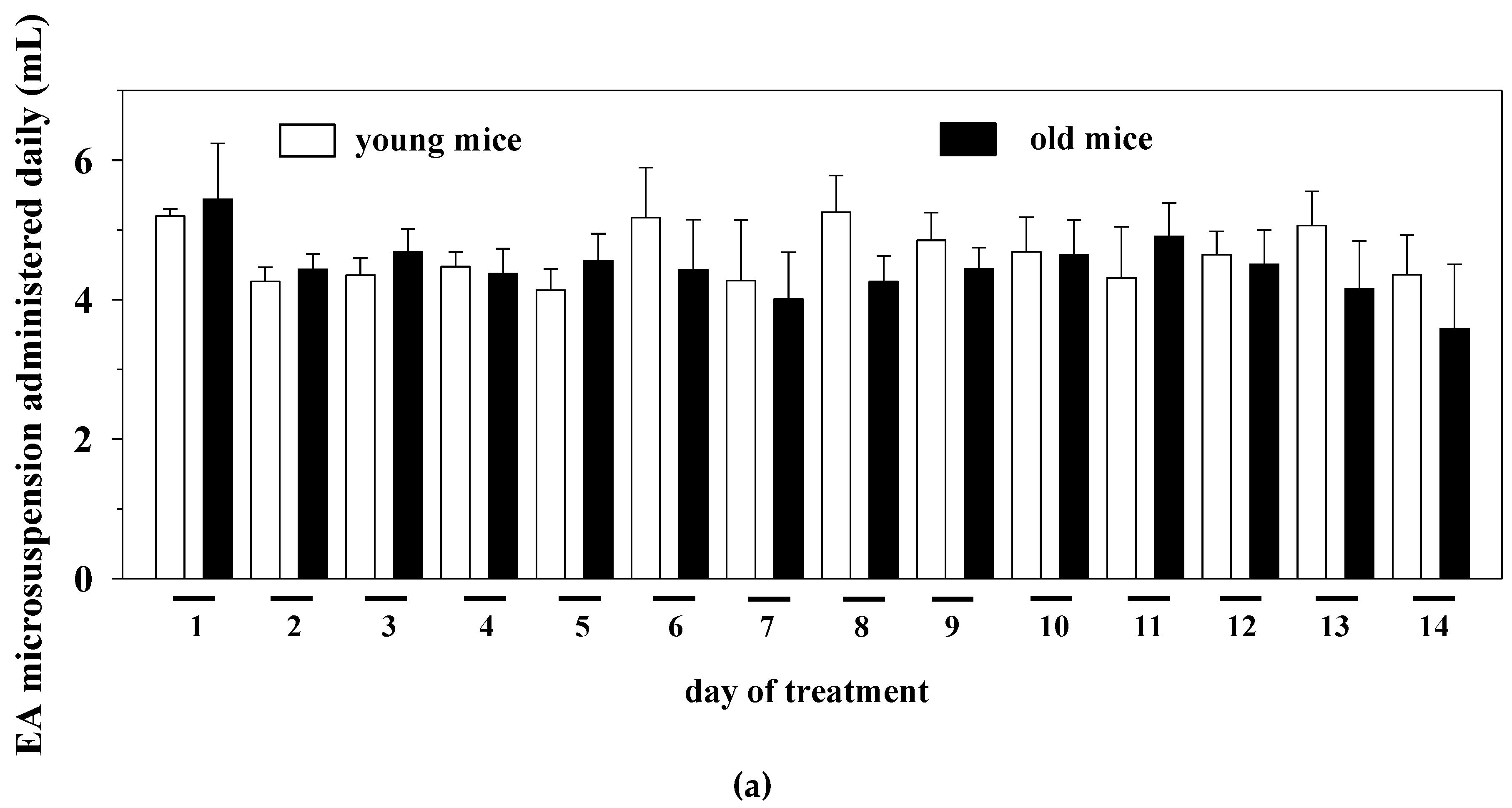
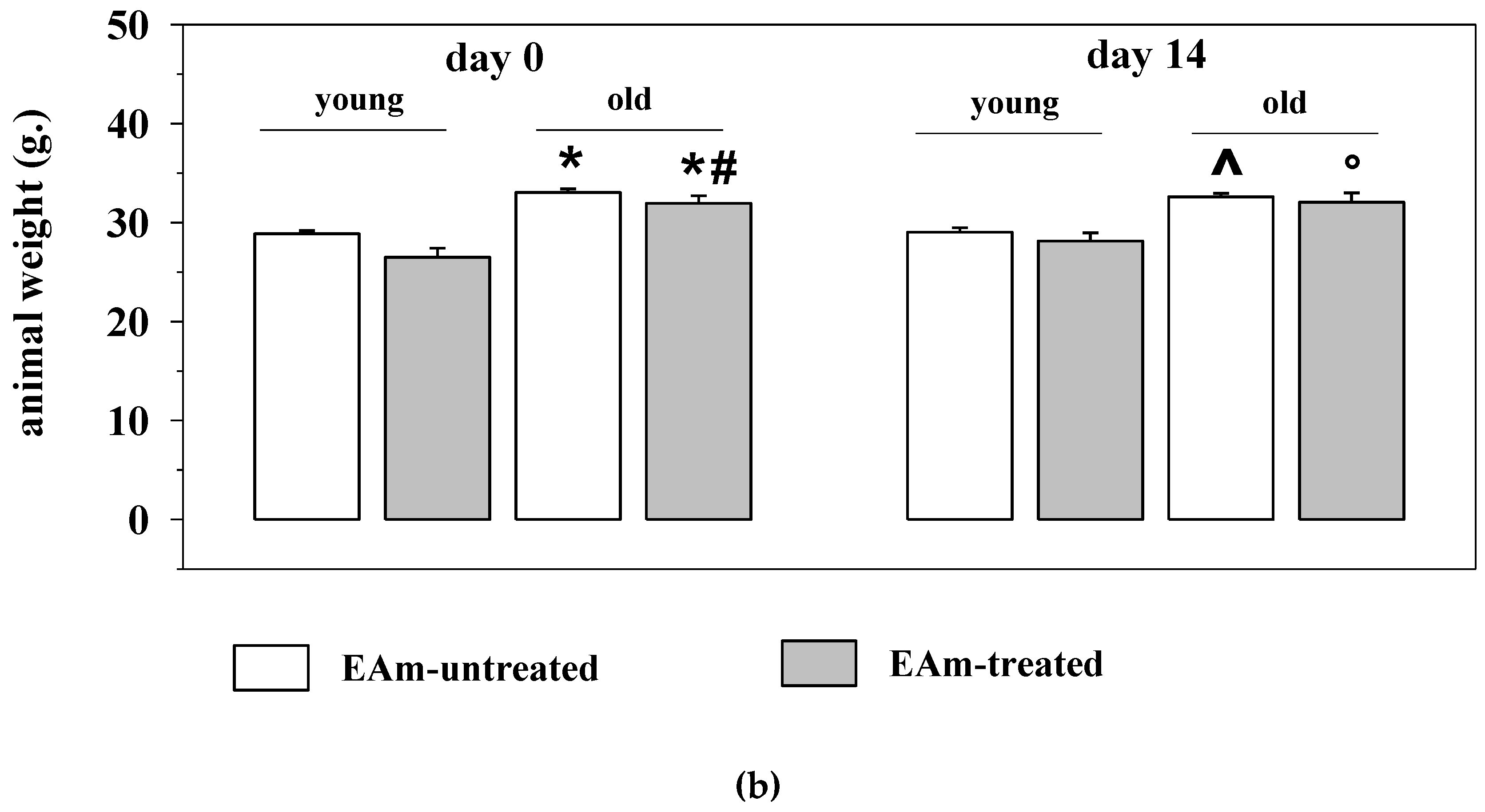
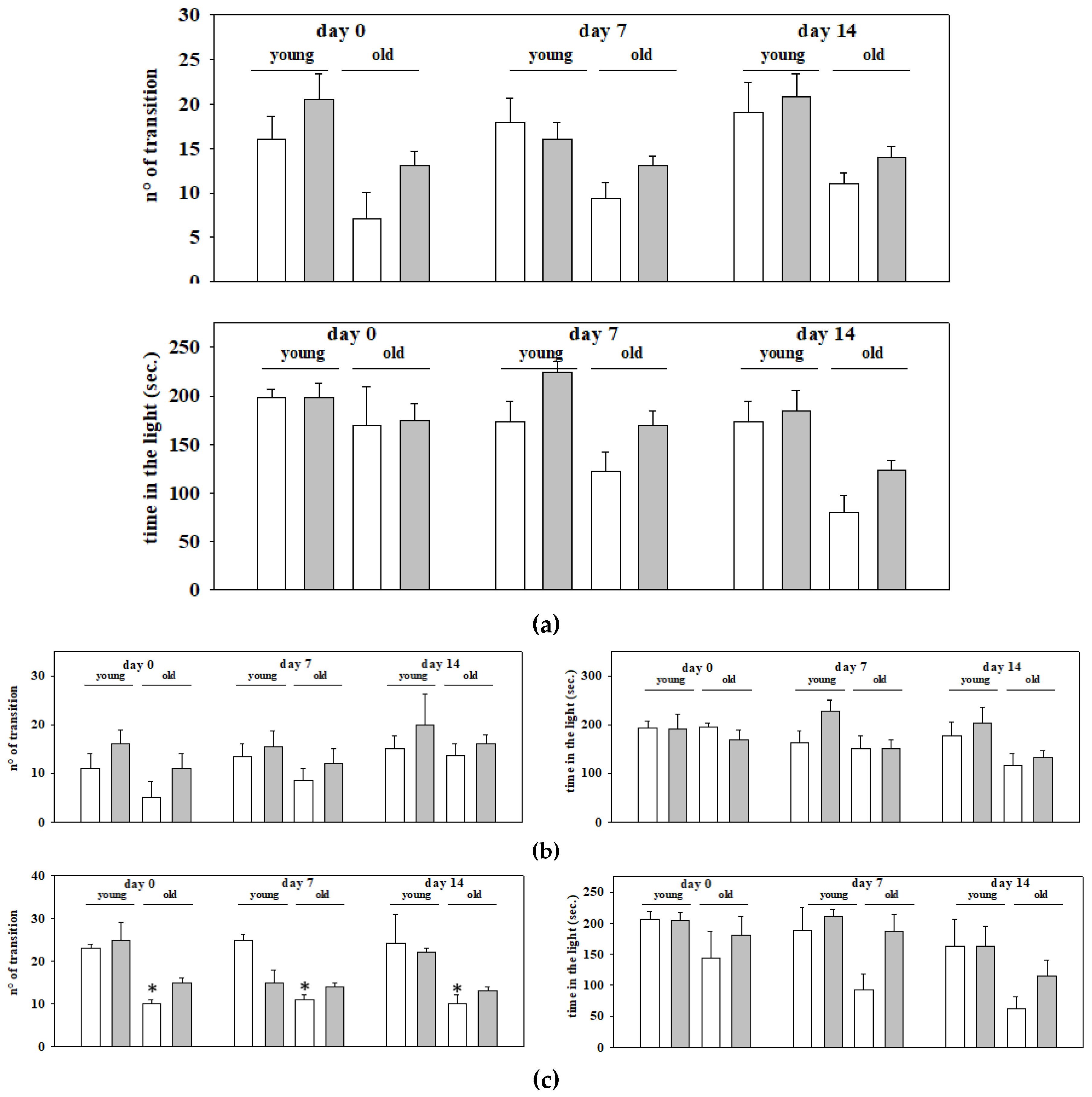

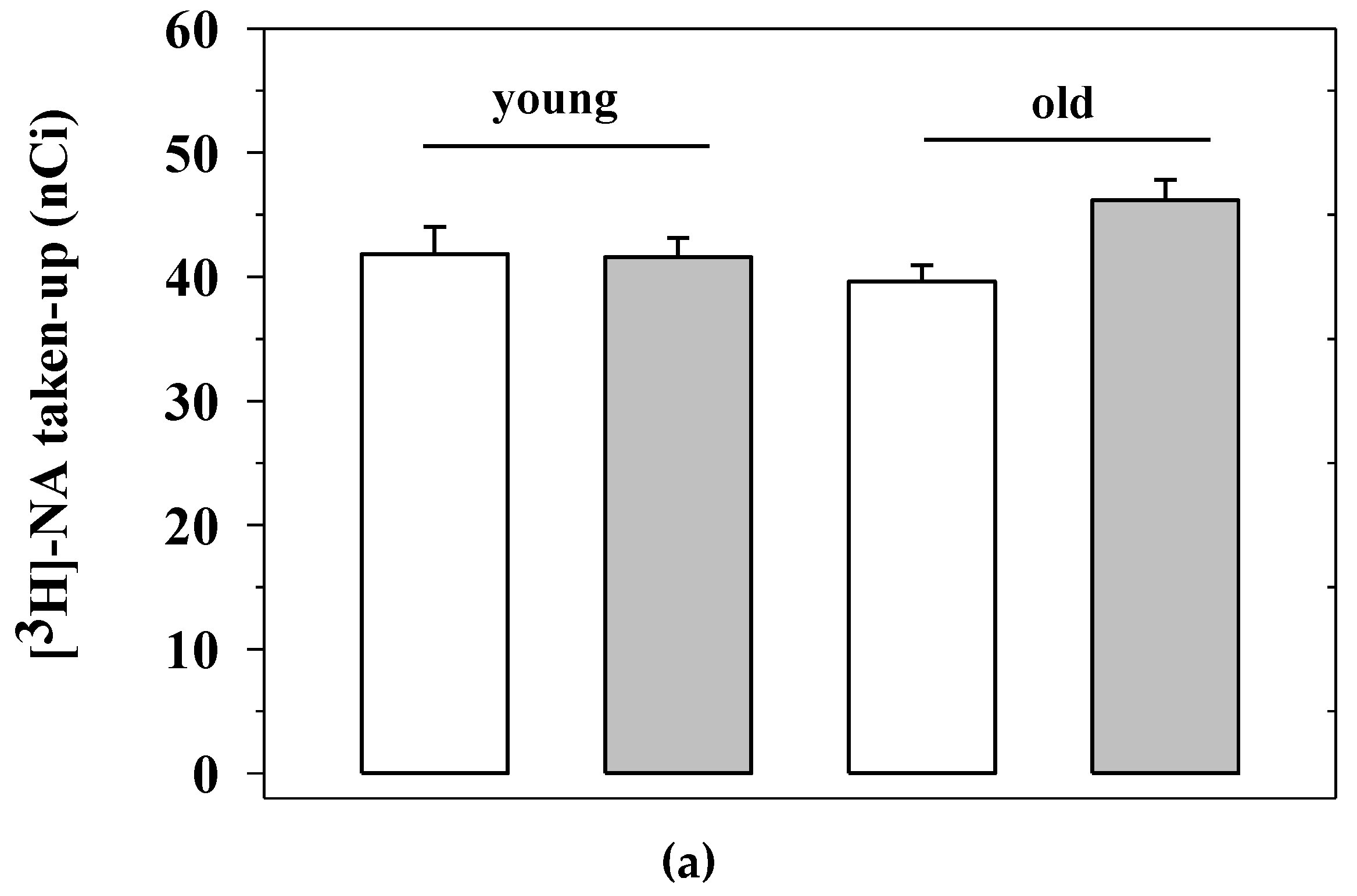
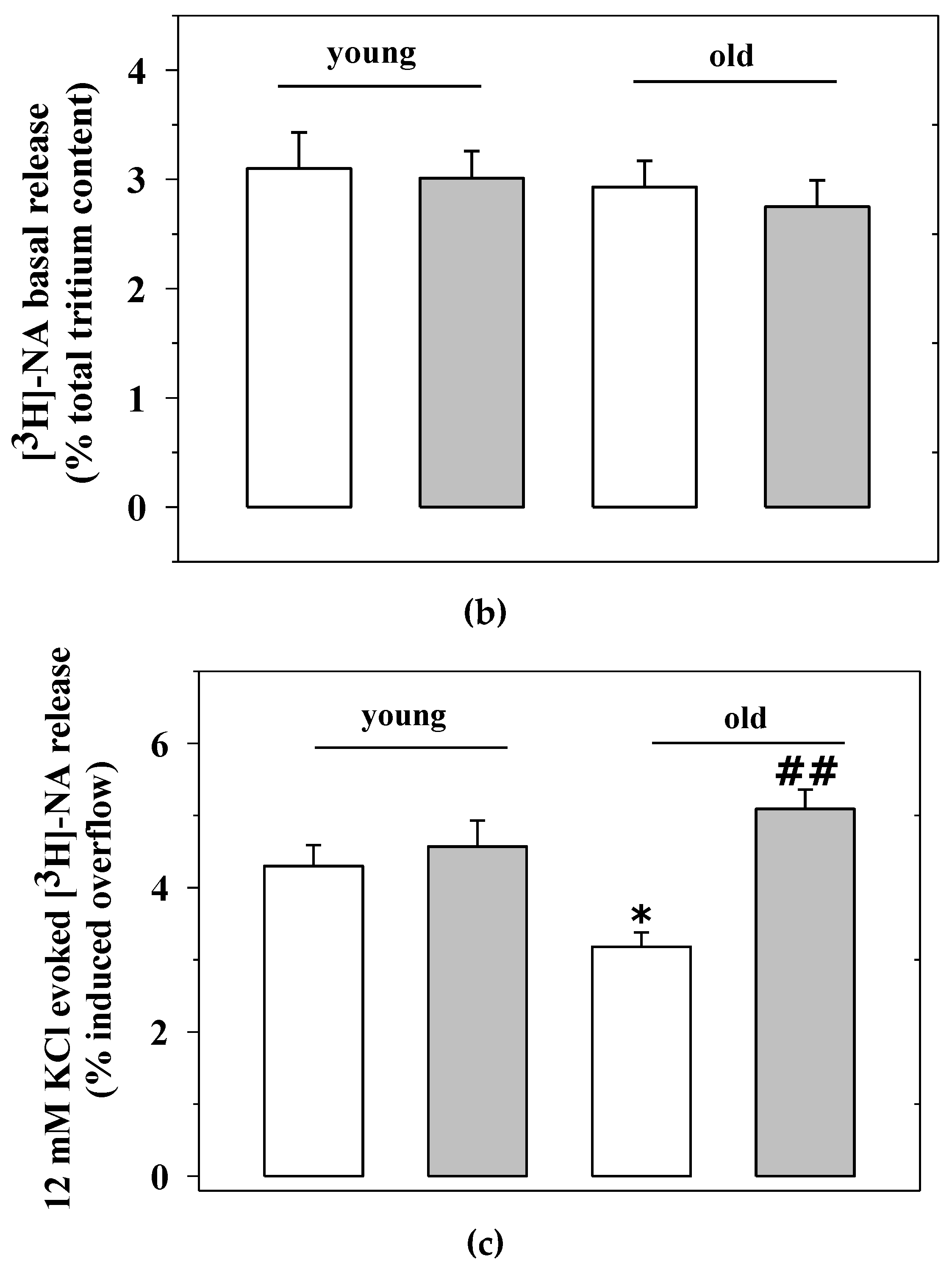
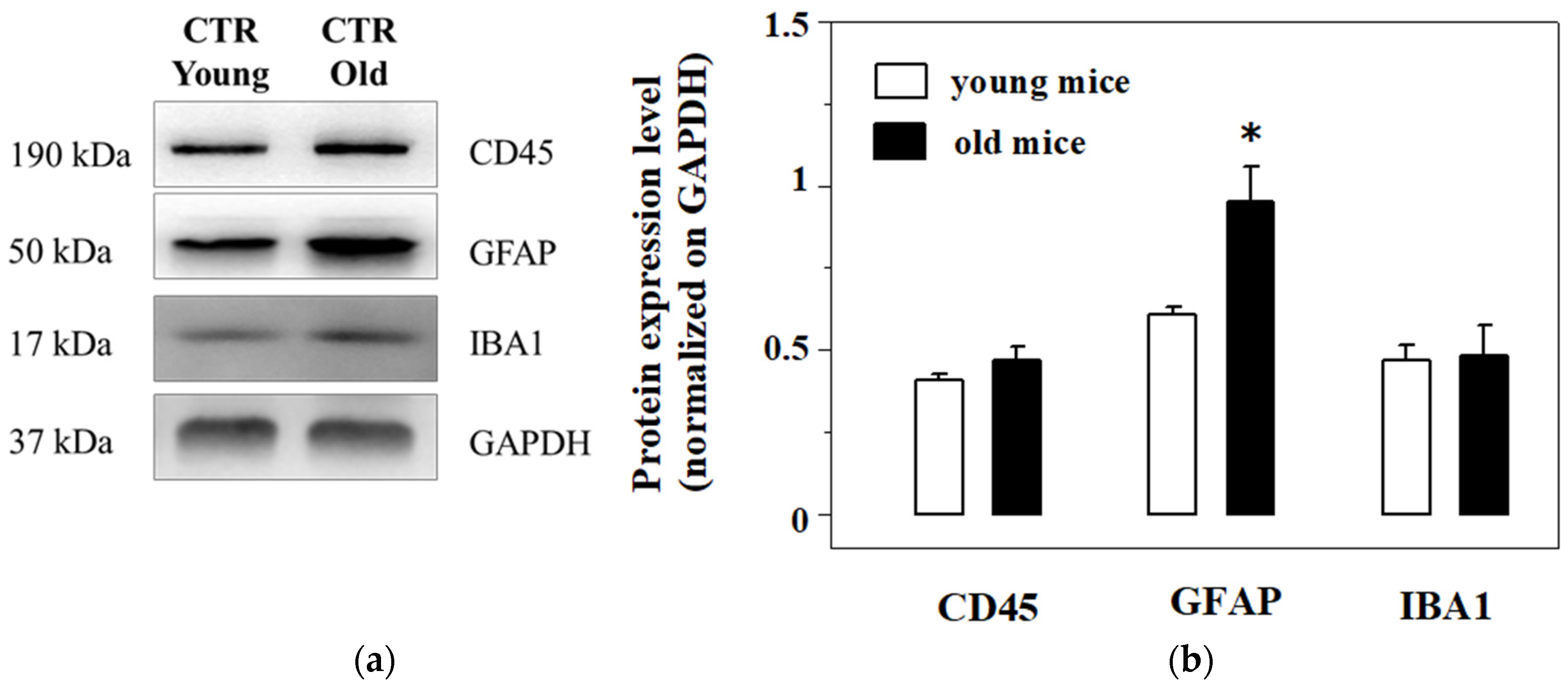
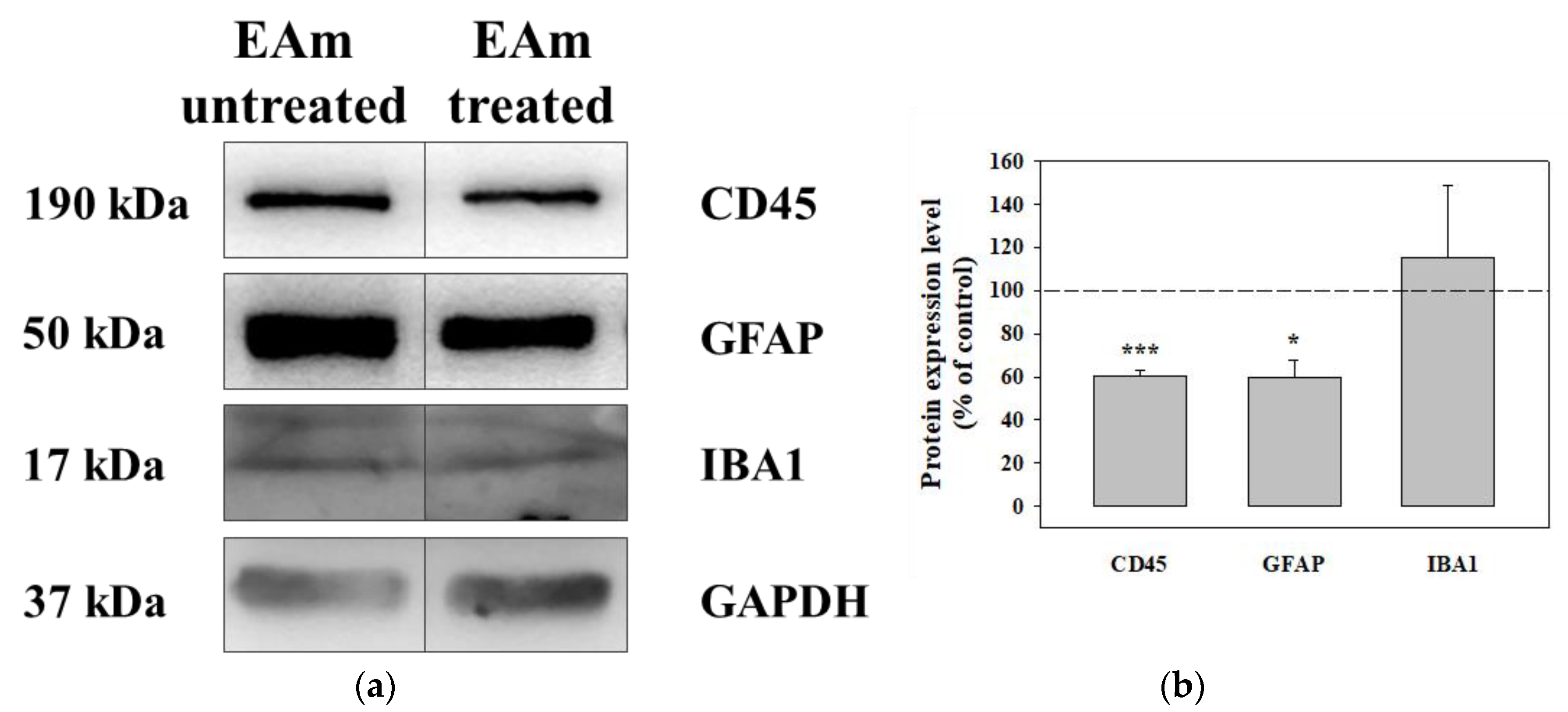
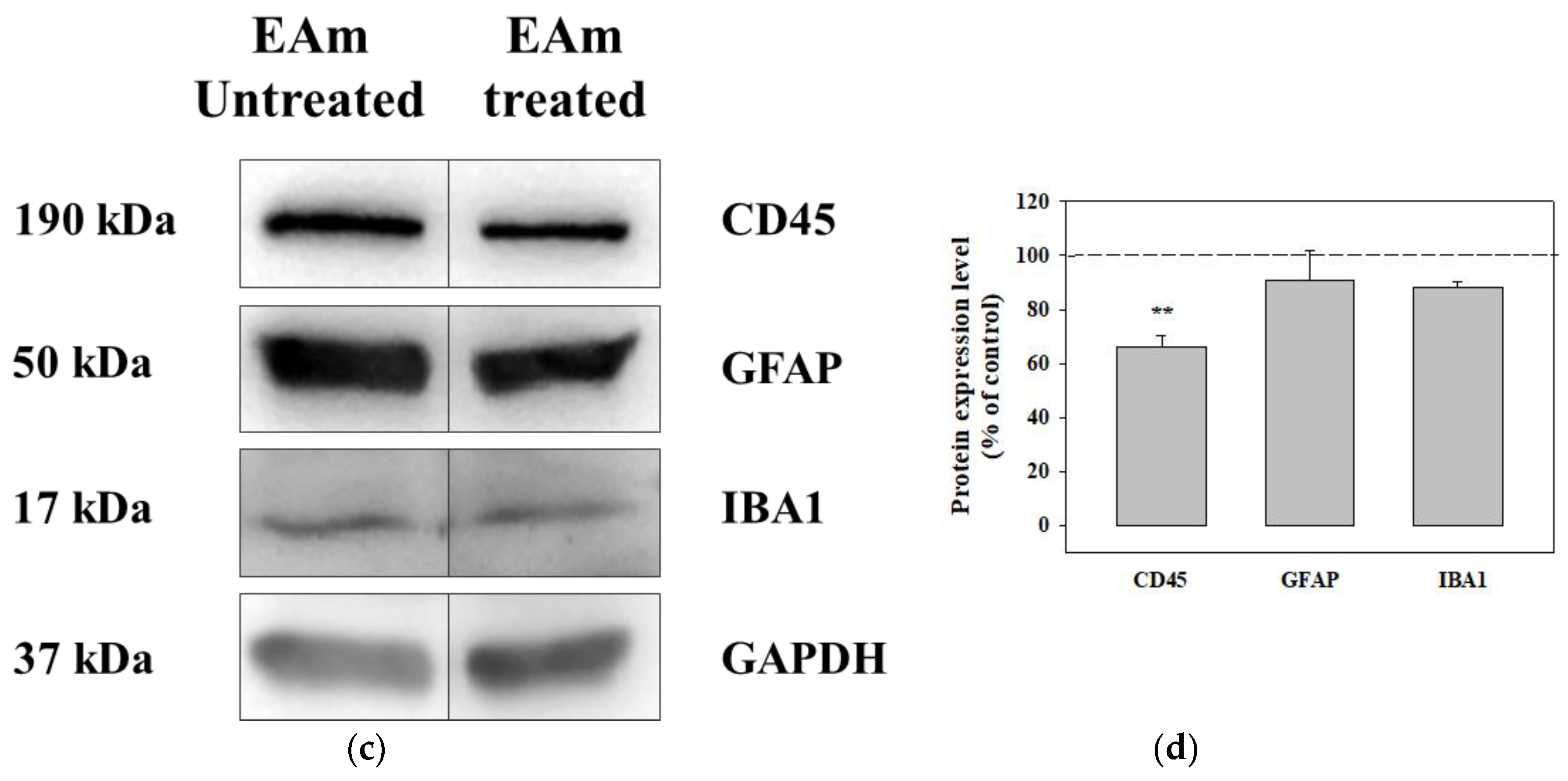
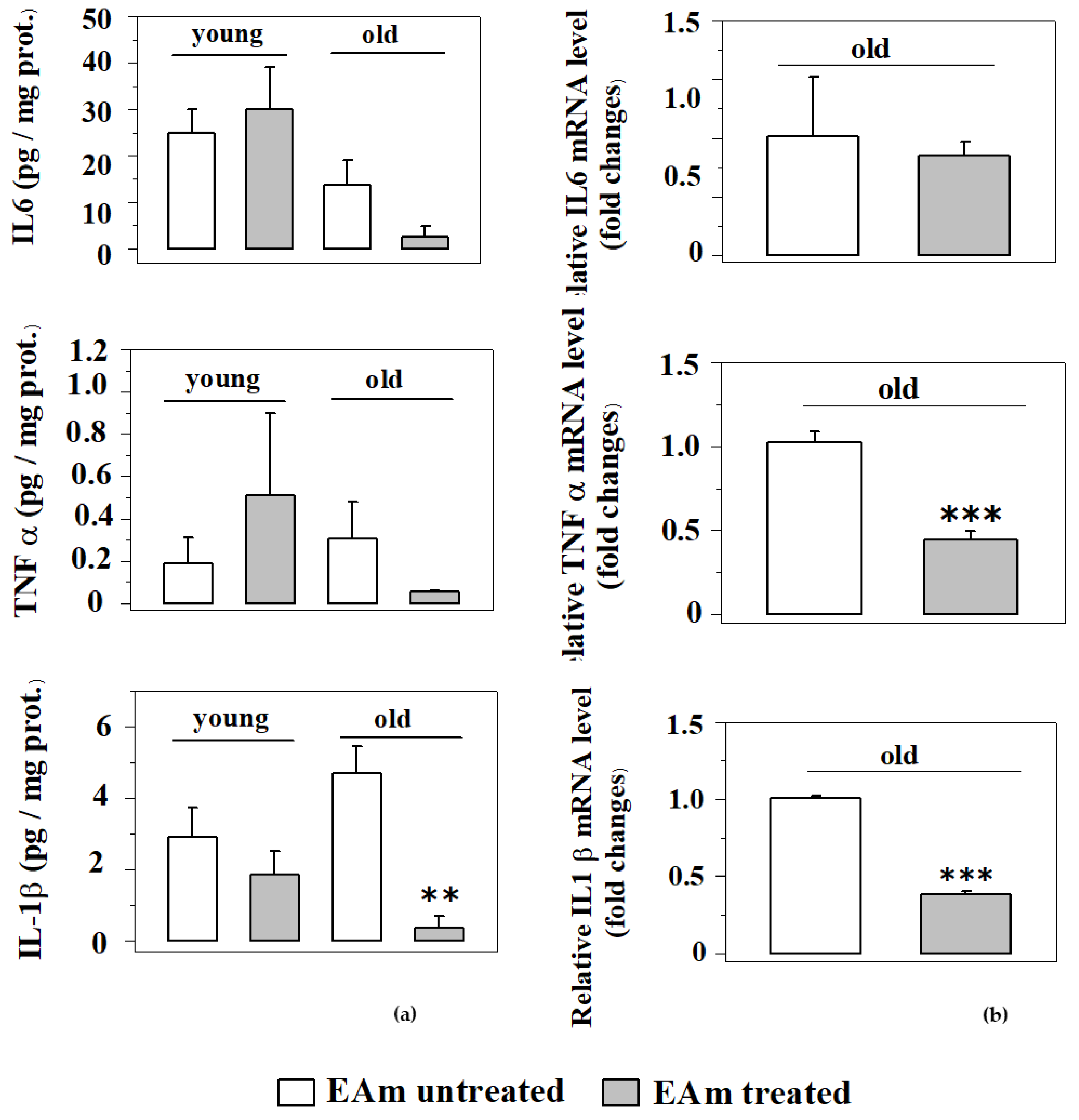
© 2020 by the authors. Licensee MDPI, Basel, Switzerland. This article is an open access article distributed under the terms and conditions of the Creative Commons Attribution (CC BY) license (http://creativecommons.org/licenses/by/4.0/).
Share and Cite
Boggia, R.; Turrini, F.; Roggeri, A.; Olivero, G.; Cisani, F.; Bonfiglio, T.; Summa, M.; Grilli, M.; Caviglioli, G.; Alfei, S.; et al. Neuroinflammation in Aged Brain: Impact of the Oral Administration of Ellagic Acid Microdispersion. Int. J. Mol. Sci. 2020, 21, 3631. https://doi.org/10.3390/ijms21103631
Boggia R, Turrini F, Roggeri A, Olivero G, Cisani F, Bonfiglio T, Summa M, Grilli M, Caviglioli G, Alfei S, et al. Neuroinflammation in Aged Brain: Impact of the Oral Administration of Ellagic Acid Microdispersion. International Journal of Molecular Sciences. 2020; 21(10):3631. https://doi.org/10.3390/ijms21103631
Chicago/Turabian StyleBoggia, Raffaella, Federica Turrini, Alessandra Roggeri, Guendalina Olivero, Francesca Cisani, Tommaso Bonfiglio, Maria Summa, Massimo Grilli, Gabriele Caviglioli, Silvana Alfei, and et al. 2020. "Neuroinflammation in Aged Brain: Impact of the Oral Administration of Ellagic Acid Microdispersion" International Journal of Molecular Sciences 21, no. 10: 3631. https://doi.org/10.3390/ijms21103631
APA StyleBoggia, R., Turrini, F., Roggeri, A., Olivero, G., Cisani, F., Bonfiglio, T., Summa, M., Grilli, M., Caviglioli, G., Alfei, S., Zunin, P., Bertorelli, R., & Pittaluga, A. (2020). Neuroinflammation in Aged Brain: Impact of the Oral Administration of Ellagic Acid Microdispersion. International Journal of Molecular Sciences, 21(10), 3631. https://doi.org/10.3390/ijms21103631










